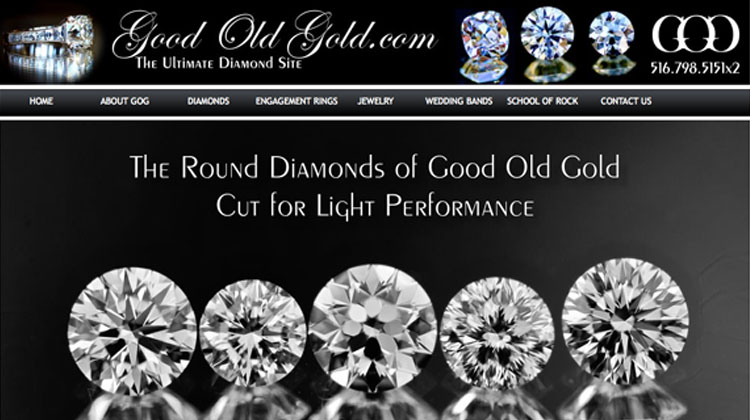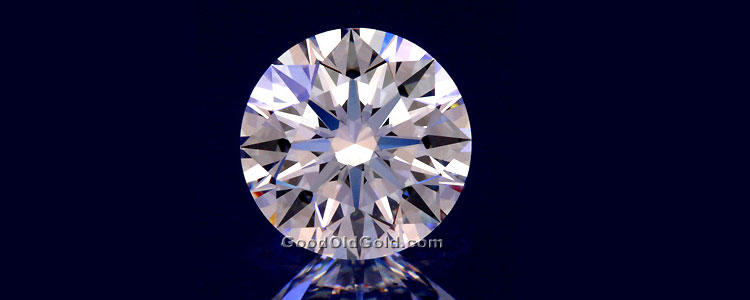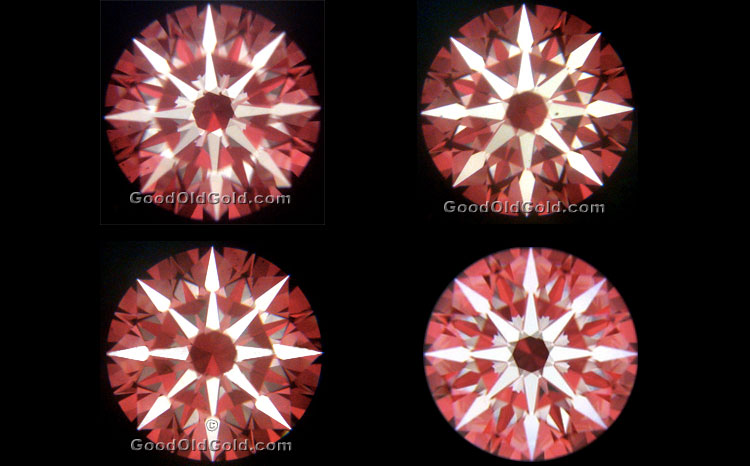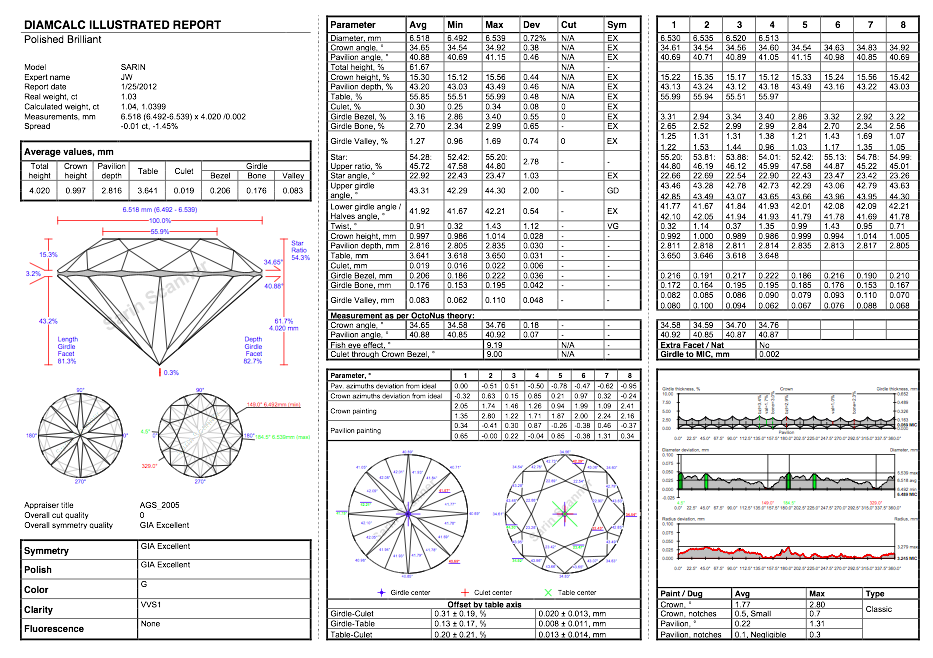
In this review, I will be looking at Good Old Gold’s Superior Hearts & Arrows Diamonds. I will also take a look at their line of Premium Ideal Cut diamonds and see how they compare.First let me give you a bit of background about their company.
Gold Old Gold is based in Massapequa, New York and is a traditional a bricks and mortar store with a very good online reputation for providing a wide range of top quality diamonds. When you’re dealing with Good Old Gold, make sure you ask for Jonathan Weingarten a.k.a. ‘Rhino’, who is one of their gemmologists used to be very active on diamond forums but still responds quickly to any questions about their company.
Their website, marketed as the ‘Ultimate Diamond Information Site’, has a lot of useful information that may go even beyond what I discuss in retutorials. Go check it out especially if you want to learn more about the different tools they use to analyse their diamonds. You should also check out Rhino’s youtube videos, where he goes by ‘diamondinfoman’, which are very good for seeing how diamonds compare under critical lighting conditions.
Quality of the Good Old Gold Superior Hearts & Arrows Diamond
Good Old Gold explains in their education pages on optical symmetry that their Superior designation is in response to the lack of optical symmetry grading by the major labs. It is obvious that Good Old Gold believes that the major labs fail to grade cut effectively, and that optical symmetry ought to be very important in regards to cut grading.
It is interesting to note that Good Gold Gold will apply their Superior designation to diamonds with longer lower girdle lengths (>80%). These diamonds will not be traditional H&A diamonds as featured by other super-ideal diamond vendors. These kinds of diamonds will have a ‘open-heart’ H&A image and will display a clef in between the hearts.
Purists will say that these are not true H&A, but in terms of beauty, Good Old Gold is correct to say that in ideal cut diamonds, a longer lower girdle length will not negatively impact the diamond and simply is a different ‘flavour’ of diamond. On top of this, did you know that ‘open-heart’ literally means ‘happiness’ in Chinese? I wonder if Rhino has ever thought about marketing it as such to the Chinese.
Good Old Gold also has a premium designation that they say are for diamonds that just miss the mark of being superior. They give two examples of the kind of defects that will make a diamond lose its superior designation:
- The arrow shafts are not aligned at the base such that the star pattern around the table reflection is distorted.
- One or more smaller hearts, which affect the hotspots at the base of the arrow shafts such that they are not uniform.
Good Old Gold also makes two claims about the near-H&A. The first is that a person will not be able to tell the difference between a superior and a premium. The second is that often, the near-H&A carry the same price premium as perfect H&A.
I think that the first statement is true for the average consumer when inspecting a diamond with the naked eye. However, under close inspection, I do believe a diamond prosumer would be able to tell the difference. One can certainly tell the difference using reflector technology such as an idealscope, ASET, or H&A viewer.
As for the second statement, you need to understand that the term near-H&A is undefined. I think what Good Old Gold is saying here is that some of their premium cut near-H&A diamonds may be so close to H&A that they command a higher premium than your typical GIA ex. In my opinion, there ought to be a significant price difference between the typical diamond that is marketed as near-H&A and perfect H&A diamonds.
Unfortunately, perfect cut has not been not as easy to define/value compared to say, perfect clarity.
The Comparison
Lets have a look at the Good Old Gold Superior H&A to see how they hold up to their description. When I use their diamond search engine, the first thing I notice is that Good Old Gold does not carry that many diamonds so I couldn’t just pick out six random diamonds that are very similar like I have done so in my past reviews. Nevertheless, I randomly selected six superior diamonds ranging from D to H and VVS1 to SI2 in clarity for the review.
All of the following are round diamonds that have GIA excellent/AGS ideal cut grade, symmetry, and polish:
| Diamond 1 | Diamond 2 | Diamond 3 | Diamond 4 | Diamond 5 | Diamond 6 | |
| Carat Weight: | 1.15ct | 1.03ct | 1.06ct | 1.22ct | 1.32ct | 1.11ct |
| Color: | D | G | G | H | H | H |
| Clarity: | VS1 | VVS1 | SI1 | VS1 | SI2 | SI2 |
| Fluorescence: | None | None | None | None | Faint | None |
| Lab Report: | AGS | GIA | AGS | AGS | GIA | AGS |
| Lab Report #: | 104065675009 | 16429580 | 104061614017 | 104047046014 | 5146492581 | 104058379005 |
| Width: | 6.75mm | 6.49mm | 6.57mm | 6.88mm | 7.04mm | 6.66mm |
| Length: | 6.76mm | 6.52mm | 6.54mm | 6.87mm | 7.02mm | 6.63mm |
| Depth: | 4.17mm | 4.02mm | 4.03mm | 4.23mm | 4.36mm | 4.11mm |
| Table Percentage: | 56.30% | 55.86% | 57.00% | 55.90% | 57.00% | 56.50% |
| Depth Percentage: | 61.80% | 61.90% | 61.50% | 61.50% | 61.90% | 61.80% |
| Crown ∠: | 34.40° | 34.50° | 35.00° | 34.70° | 34.50° | 34.90° |
| Pavilion ∠: | 41.10° | 40.80° | 40.80° | 40.80° | 41.20° | 40.80° |
When I look at the diamonds in the above tables, I immediately see that in general the table facet percentages are in between 55% to 57%. I also note that the depth percentages are all less than 62%. I am disappointed that there is no immediate information regarding the girdle, but quickly checking the lab reports of some of these diamonds reveal that most of them have thin to medium girdle thickness, very nice. So far, the Good Old Gold Superior H&A at least match that of Whiteflash’s ACA.
The crown angles are mostly around 34.5 and 35 degrees and the pavilion angle combinations are mostly 40.8 degrees with two exceptions. I will have a look at those more closely in a bit. All proportions fall within my recommended specifications, the only thing I will say is that the superior H&A line does not have any particular look to them and they seem to be all selected by Good Old Gold for their light performance and overall visual appearance. To confirm this let me have a closer look at the two diamonds with the steeper pavilion angles.
First the 1.15ct DVS1 (Diamond #1):
At first glance, the actual image of the diamond seems to show the brightness of the diamond under the table as strong and balanced. It is expected that the top half of the diamond appears brighter than the bottom half. When I first saw this image, I thought it was very weird that the crown is relatively darker than the rest of the diamond.
I think this may be a photography issue because I have since gone on to check every one of Good Old Gold’s Superior H&A’s actual images and it does seem that the relative darkness of some of the facets seem to be flipped.
I will illustrate what I mean by the following example of a 1.53ct KVS1 with lab#9977210.
The first image is of the actual diamond picture on the Good Old Gold website, the second is taken off of a recent video of the same diamond. Have a look at the bright crown in the video and a dark table reflection. This is opposite of the dark crown and the bright table reflection. Also notice the much more dark bottom half of the diamond in the video compared to the image on the website.
Lets get back to Diamond #1. Below is the hearts image.
As you can see, the hearts all have a clef in between them indicating a >80% lower girdle length. There is the slightest distortion of a couple of the hearts at the tip indicating that there is minor yawing, something that I can accept even in the top-of-the line H&A diamonds. There are some great things going on in this diamond.
First, all the hearts are the same size so I would expect the hotspots to be fairly uniform and also that the opposing V’s are actually quite symmetrical, an important link between optical symmetry and light performance. Also, the separation between the hearts and the V’s are uniform indicating tight variances in the lower girdles.
Good Old Gold does not provide an idealscope image, instead they use their own technology known as a diamxray. A diamxray works in the same way as an idealscope but is designed to work with a much stronger backlighting. Good Old Gold says that it is possible to be more critical with a diamxray than an idealscope image.
Here is the diamxray image of Diamond #1. Looking at the hotspots, they are fairly uniform as expected at the base of the arrow shafts. As with all arrow views, slight tilt will affect photography so any comments as to optical symmetry should only be generalised.
My biggest problem with diamxray is that it may be confusing for consumers that think it is an idealscope. These technologies are different and the diamxray reveals flaws in the diamond that an idealscope does not.
Compare Diamond #1 with this diamxray image of another diamond. The differences in photographs makes me question how to really analyse these images. Nevertheless, I do not see any leakage under the table in Diamond #1 that many people fear with diamonds that have a pavilion angle at or above 41 degrees.
Now lets have a look at the other potentially problematic diamond, the 1.32ct HSI2 (Diamond #5).
First the actual image:
Just looking at this image, the arrows don’t appear very dark. They seem to not be reflecting as much head shadow/body obstruction as you would normally expect. However, the diamond appears to be overall brighter than the DVS1. My reservations about the photography has made me a bit cautious of this stone.
The hearts image looks fine with the only obvious defect at the nine o’clock heart where the two sides of the heart doesn’t line up.
The diamxray of this diamond can be a bit confusing. The image seems to confirm that the head shadow/body obstruction is weak in the arrows. But the whole image seems to display this darker color, from the upper girdles, to the lower girdles, and even in the table reflection.
This may be just because the comparatively strong backlighting used in the diamxray. Remember that the darker areas here is not indicating light leakage but rather indicating that there is partial light return. What is clear is that there does appear to be lighter pinks under the table than the previous images I have reviewed and this is directly related to a steeper pavilion angle. They are not yet to the point of leaking though, which can be seen by comparing to the white spots of leakage in the upper girdles that are expected.
Again, there is a possibility that the dark areas are an issue with photography. This possibility does not sit well in the back of my mind. Perhaps I will run these questions by Rhino and see if he will shed some light and then I will come back and make whatever changes are necessary to this review. But what is certain is that I have looked at 3 diamxray images and all 3 are so different that it makes me feel like these images are not particularly helpful to the average consumer.
Quality of the Good Old Gold Premium Hearts & Arrows Diamond
Earlier in this review I have already mentioned two of the defects that can make a diamond miss the mark on a superior designation. I will repeat them here for convenience.
• The arrow shafts are not aligned at the base such that the star pattern around the table reflection is distorted.
• One or more smaller hearts, which affect the hotspots at the base of the arrow shafts such that they are not uniform.
For simplicity, I will randomly look at several arrows images of Good Old Gold’s Premium Ideal Cut Round.
The images above suggests to me that there are an undefined number of variations that Good Old Gold may consider to be premium. From what I can tell, a main consideration is whether the diamond displays an arrows pattern. The four images above show various defects that you can find within the premium ideal cut designation. Most of the defects can be attributed to misalignment and twisting of the diamond in the azimuthal plane due to yaw.
The last image shows what a diamond with one smaller heart would look like.
Here is the hearts image of the same diamond. You can see the smaller heart at the eight o’clock position. The heart is further away from the V because the lower girdle length at that point is longer than the others. The point is that if you want a premium cut diamond, there is a very wide range of diamonds and some will be closer to the Superior designation than others.
Price
Like many vendors, Good Old Gold offers a bank wire discount. I had a look to see how the prices at Good Old Gold compared to James Allen, which I found had very competitive prices. A 1.02ct HVS2 Superior H&A was listed at $8,218. A comparable 1.02ct HVS2 True Heart from James Allen on the other hand is $7,510 (with further discounts available). The 10% extra that you are paying is for the many value added services that Good Old Gold provide starting with information, lots and lots of information.
Information Provided
When you purchase a Superior H&A diamond from Good Old Gold, you get an actual image, the diamxray, an ASET, hearts and arrows images, brilliantscope/gemex results, Isee2 results, and a photomicrograph showing the location of the inclusion.
Remember that information is only as good as the ability to interpret it. The brilliantscope counts the frequency of flashes with a stationary diamond and a moving light source. However, the brilliantscope does not take into account optical symmetry, contrast, or painting of the upper girdles.
Therefore, there is a need for Isee2 technology, which assesses the contrast, brightness, and optical symmetry of the diamond and gives it a score out of 10. Apparently a perfect score is impossible to achieve. Neither of these technologies adequately measures the fire of a diamond.
On top of the brilliantscope and the Isee2, you also get a Helium report, which is the most comprehensive diamond report available. Just have a look yourself.
Also, because Good Old Gold is a brick and mortar store and Rhino is such a nice guy and really has passion in what he does, you are sure to get great customer service and have all this info explained to you when you go there in person. If you are looking for a tailored diamond purchasing experience, you probably should look no further.
Ease of Searching a Diamond
Good Old Gold has one of the best diamond search engines on the internet allowing you to literally search for any proportion combination. The only problem is that their limited inventory negates the usefulness of the search engine. But because they don’t have a lot of diamonds, it is also easy to find the diamond they have or don’t have for your specifications.
Another real plus for Good Old Gold is that they carry a very wide range of superior fancy cuts if that is what you’re looking for. Once you learn your preferences for light performance and diamond character, Good Old Gold may have a special cut that specifically appeals to you. One thing I really like about the Good Old Gold diamond search filter is the ability to expand the details of all their diamonds in the list. It allows you to quickly see all the important information about the diamond immediately, which is very nice.
Value Adding Company Policies
Good Old Gold has a 30-day return policy (less shipping), which I find average for the industry. Where the Good Old Gold policies shine is that they have a lifetime trade-up policy where you can get a 100% credit (again less shipping) toward another diamond that is equal or greater in value. They also have a buy-back policy where they will buy back your diamond at any time for 25% less than what you paid for it.
This policy is one of the best I’ve seen in the industry. Finally, Good Old Gold can help your online buying experience by making a video for you. The only caveat, although understandable, is that there is a requirement for a $500 refundable deposit before they will make a video for you. Perhaps the best value adding service is the quality of the personalised service that you are going to get from them.
(Edit: I have been informed by Rhino that they do not always require a $500 deposit. I am awaiting him to clarify this particular point but for now, I would simply like to remind readers that it takes resources, time, effort, dedication, all translating to money in order to produce these videos and you should not take offence to any requirements that vendors ask for in going the extra mile to give you some reassurance when making your purchase.)
Conclusion
I hope that I have covered most of the important points about Good Old Gold, their diamonds, and their value added services. The Good Old Gold Superior H&A diamonds are undoubtedly some of the most precision cut diamonds in the world. Every diamond in the Good Old Gold inventory is handpicked for their appearance, and each one will be uniquely suitable to a lucky consumer out there.
Although Good Old Gold does not aim to be the cheapest vendor, their value add services are among the best in the industry.
I recommend purchasing a Superior H&A from Good Old Gold if you are looking for a super-ideal diamond with longer lower girdles for more pin fire flashes. I would also recommend them for those who are looking for the peace of mind of having as much information as is physically possible for a diamond.
The Premium ideal cut range encompasses a wide range of diamonds. As far as I can tell, these are diamonds that are handpicked within the AGS0/GIAex cut grade that have aligned arrows with no major optical asymmetry. It is probably worthwhile to be more particular with Good Old Gold if you want to find a particularly nice Premium ideal cut diamond.
If you are not going to be particular, there are cheaper alternatives out there for those on a tight budget working to maximise their bang for the buck. But if you value the experience of purchasing from a brick and mortar store, along with the quality of the customer service, then I can’t think of a better place than Good Old Gold.










